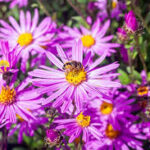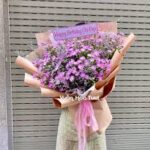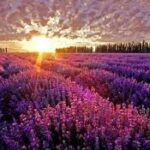
Flowers have long been a source of inspiration and symbolism in art and culture, transcending geographical and temporal boundaries. Their beauty, diversity, and ephemeral nature have influenced various artistic expressions and cultural practices throughout history. In this comprehensive exploration, we delve into the profound impact of flowers on the realms of art and culture, highlighting their significance as subjects of artistic creation, symbols of meaning, and catalysts for cultural expression.
**1. Symbolism and Meanings**
Flowers have rich symbolic meanings that vary across cultures and historical contexts. Different flowers carry specific connotations and emotions, often conveyed through art and literature. For example, roses are universally associated with love and passion, while lotus flowers symbolize purity and enlightenment in Eastern traditions. Understanding floral symbolism enriches the interpretation of artworks and enhances cultural appreciation.
**2. Artistic Representation**
Flowers have been a popular subject in visual arts, serving as motifs in paintings, sculptures, and decorative arts. Artists throughout history, from the Dutch Masters to the Impressionists and beyond, have explored the aesthetic qualities of flowers, capturing their colors, textures, and forms with exquisite detail. Floral still life paintings, botanical illustrations, and garden scenes evoke themes of beauty, transience, and the cycles of nature.
**3. Gardens and Landscapes**
The cultivation of gardens and landscapes has been an integral part of human civilization, reflecting cultural values and aesthetic sensibilities. Formal gardens like those of Versailles exemplify artistic precision and grandeur, while Japanese Zen gardens embody simplicity and harmony with nature. Flowers play a central role in garden design, influencing spatial composition and sensory experiences. Public parks and botanical gardens showcase floral diversity and promote environmental awareness.
**4. Literary Inspiration**
Flowers have inspired poets, writers, and storytellers across cultures, serving as metaphors for human emotions and experiences. In classical literature, floral imagery often conveys themes of love, beauty, and mortality. Shakespearean sonnets abound with references to roses, violets, and daisies, each symbolizing different facets of romantic longing and devotion. Flower symbolism enriches narrative depth and emotional resonance in literary works.
**5. Rituals and Ceremonies**
Flowers play essential roles in religious rituals, ceremonies, and rites of passage, infusing cultural practices with symbolic significance. From wedding bouquets to funeral wreaths, flowers mark significant life events and transitions. Floral offerings in religious ceremonies symbolize devotion, purity, and divine grace. The use of flowers in cultural rituals fosters communal bonds and strengthens connections to spiritual beliefs and traditions.
**6. Cultural Traditions**
Flowers are woven into the fabric of cultural traditions, serving as symbols of identity, heritage, and social customs. In Hawaii, the giving of leis (flower garlands) symbolizes hospitality and the spirit of aloha. In India, marigolds are used in festive decorations and religious ceremonies, signifying auspiciousness and prosperity. Cultural traditions involving flowers highlight the reverence for nature and the interconnectedness of human communities with the botanical world.
**7. Fashion and Design**
Floral motifs have influenced fashion and design across centuries, adorning textiles, jewelry, and decorative arts. Floral patterns evoke themes of femininity, beauty, and romance in haute couture and ready-to-wear fashion. Art Nouveau and Art Deco movements embraced organic forms and floral designs, showcasing nature’s elegance in architecture and decorative arts. Floral-inspired accessories and botanical prints continue to resonate in contemporary design aesthetics.
**8. Healing and Well-Being**
Flowers have therapeutic properties that promote healing and emotional well-being in holistic practices. Aromatherapy harnesses the aromatic essences of flowers like lavender, rose, and chamomile to reduce stress and induce relaxation. Herbal medicines derived from flowers, such as calendula and echinacea, have medicinal properties that support holistic health. Cultivating flowers in home gardens enhances mental wellness and fosters connections to nature.
**9. Iconography and Iconology**
Flowers have symbolic meanings in religious iconography and iconology, representing virtues, attributes, and spiritual concepts. In Christian art, the Virgin Mary is often depicted with lilies, symbolizing purity and motherhood. Buddhist art features lotus flowers as symbols of enlightenment and spiritual awakening. Floral motifs in ancient civilizations, such as Egyptian lotus symbols and Greek floral patterns, reveal cultural beliefs and mythological narratives.
**10. Contemporary Artistic Expressions**
In contemporary art, flowers continue to inspire innovative and experimental expressions, challenging traditional aesthetics and conceptual boundaries. Installation art, performance art, and digital media incorporate floral themes to explore themes of identity, memory, and environmental consciousness. Artists employ flowers as mediums of expression, blurring the lines between nature, culture, and artistic innovation.
In summary, flowers exert a profound influence on art and culture, shaping aesthetic sensibilities, symbolic meanings, and creative expressions across diverse societies. Their timeless beauty and cultural significance serve as bridges between the natural world and human experiences, enriching the tapestry of human creativity and collective imagination.
**Flowers and Their Impact on Art and Culture (Part 2)**
Continuing our exploration of the profound influence of flowers on art and culture, we delve deeper into their role as transformative symbols, creative inspirations, and integral elements of human expression across diverse societies and historical contexts.
**11. Symbolism and Cultural Significance**
Flowers hold deep symbolic meanings that resonate within specific cultural contexts. For example, in Japanese culture, cherry blossoms (sakura) symbolize the transient beauty of life and are associated with the ephemeral nature of existence (mono no aware). The lotus flower holds profound spiritual significance in Hinduism and Buddhism, representing purity, enlightenment, and rebirth. Understanding floral symbolism enhances cultural literacy and fosters appreciation for the layers of meaning embedded in artistic and cultural expressions.
**12. Art Movements and Floral Aesthetics**
Throughout art history, flowers have been integral to various artistic movements and aesthetics. The Impressionists, inspired by the play of light and color in nature, depicted vibrant floral scenes with loose brushstrokes and vivid palettes. Art Nouveau embraced organic forms and floral motifs, incorporating natural elements into decorative arts, architecture, and graphic design. Floral aesthetics continue to evolve in contemporary art, exploring themes of beauty, impermanence, and the human connection to nature.
**13. Botanical Illustration and Scientific Discovery**
Botanical illustration has played a crucial role in scientific discovery and botanical classification. Artists like Maria Sibylla Merian and Pierre-Joseph Redouté produced meticulously detailed illustrations of plants and flowers, documenting botanical specimens for scientific study and exploration. Botanical art combines artistic skill with scientific accuracy, preserving the diversity and beauty of plant life for future generations.
**14. Floral Festivals and Cultural Celebrations**
Floral festivals celebrate the beauty and cultural significance of flowers, showcasing artistic creativity and community spirit. Events like the Chelsea Flower Show in London and the Philadelphia Flower Show feature elaborate floral displays, garden installations, and horticultural exhibits. Local flower festivals around the world highlight regional floral traditions, from cherry blossom festivals in Japan to tulip festivals in the Netherlands, promoting cultural exchange and tourism.
**15. Environmental Awareness and Conservation**
Flowers inspire environmental awareness and conservation efforts, highlighting the importance of biodiversity and habitat preservation. Botanical gardens and arboreta serve as living museums, conserving rare and endangered plant species for research and education. Artists and activists use floral imagery to advocate for environmental sustainability and raise awareness about climate change and habitat loss. The intersection of art, culture, and conservation promotes stewardship of natural resources and the protection of floral diversity.
**16. Floral Design and Decorative Arts**
Floral design encompasses a wide range of creative practices, from floral arrangements and garden design to interior decoration and event styling. Floral designers blend artistry with horticultural expertise, creating harmonious compositions that evoke mood and emotion. Ikebana, the Japanese art of flower arranging, emphasizes minimalist aesthetics and spiritual principles. Floral motifs adorn decorative arts such as textiles, ceramics, and jewelry, infusing everyday objects with natural beauty.
**17. Cultural Heritage and Intangible Traditions**
Flowers contribute to the preservation of cultural heritage and intangible traditions, embodying shared values and collective memories. Traditional crafts like garland-making, flower weaving, and floral embroidery pass down ancestral knowledge and artistic techniques through generations. Indigenous communities incorporate native flora into rituals and ceremonies, honoring ancestral connections to the land and reaffirming cultural identities.
**18. Social Rituals and Everyday Life**
Flowers enrich social rituals and everyday experiences, enhancing social interactions and emotional connections. Gift-giving traditions involving flowers, such as bouquets for birthdays and anniversaries, express affection and celebrate milestones. Floral arrangements in public spaces and private homes create inviting atmospheres and promote well-being. Flowers symbolize hope, resilience, and renewal, serving as reminders of life’s beauty amidst challenges.
**19. Interdisciplinary Collaborations**
Flowers inspire interdisciplinary collaborations between artists, designers, scientists, and environmentalists. Creative partnerships explore the intersection of art, science, and sustainability, fostering innovative approaches to floral art and cultural expression. Floral installations in urban landscapes promote green infrastructure and community engagement, reimagining public spaces as vibrant hubs of creativity and ecological awareness.
**20. Global Connections and Cross-Cultural Exchange**
Flowers facilitate global connections and cross-cultural exchange, transcending linguistic barriers and fostering mutual understanding. International floral exhibitions, workshops, and residencies bring together artists and enthusiasts from diverse backgrounds, celebrating the universal appeal of flowers as a source of beauty and inspiration. Collaborative projects promote cultural dialogue and creative exchange, bridging differences and nurturing global solidarity.
In summary, flowers exert a profound impact on art and culture, influencing aesthetic sensibilities, symbolic languages, and communal experiences across societies and generations. Their enduring allure as subjects of artistic creation and cultural expression reflects humanity’s deep-seated connection to the natural world and the transformative power of beauty and creativity.
—
This extensive exploration illuminates the multifaceted impact of flowers on art and culture, underscoring their role as catalysts for creativity, symbols of meaning, and agents of cultural exchange. Explore the timeless beauty and transformative significance of flowers in shaping human experiences and fostering connections across diverse landscapes of art and cultural expression.










